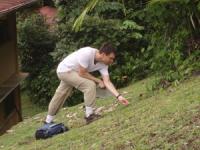Man under a microscope: using biology to study society
Nov. 10, 2011
Human societies have a lot in common with ant, wolf, dolphin and chimp societies, so adding some biological tools and techniques to the traditional methods used to study can help show these similarities, as well as differences, a group of researchers assert.
Studying human societies using biological tools can expose certain patterns – consistent relationships between economic growth and energy use, and energy use and fertility, for example -- that traditional sociological and anthropological tools may miss.
So a group of coupled human and natural systems (CHANS) researchers have proposed doing just that: a macroecological approach, which uses a large-scale, statistical focus to identify and interpret patterns across human societies.
The research was published online in July by the journal Biological Reviews.
“We’re arguing that macroecology offers valuable tools to study humans,” said William Burnside, biology doctoral candidate at the University of New Mexico and lead author of the paper. “Most social scientists either focus on the uniqueness of certain human patterns -- such as patterns of association or resource use -- or always compare humans with humans. Likewise, most ecologists assume humans are so unique and self-aware as to be beyond ecological study or that understanding human society is necessarily the purview of social scientists.”
Burnside also is a member of CHANS-Net, the International Network of Research on Coupled Human and Natural Systems.
He cited the relationship between energy use and economic growth as an example. Analyzing worldwide data, researchers found a consistent relationship between higher income (measured as per capita gross domestic product) and increased energy use, both within nations over time and among nations throughout the world.
“Economic growth generally ‘requires’ increased energy use, but wealthier nations tend to get more growth for each additional unit of energy used,” Burnside explained. “This economy of scale closely mirrors that within animal bodies, where larger creatures need less energy per unit weight than smaller animals. Think of the leisurely grazing of elephants versus the ravenous appetite of a shrew. So in the paper, we caution that calls by politicians to grow the economy while using less energy may be more difficult to achieve than they imagine.”
The research echoes earlier work that developed an analogy between the anatomy and function of a human society and that of an individual animal. Both require resources to fuel themselves and stay alive, which they get through networks. Biological metabolism is powered by sugars and micronutrients and delivered by vascular networks. Modern “industrial metabolism” is powered by oil, coal, natural gas, solar and other types of power. Fuels and electricity are delivered by networks of pipelines, power grids, roads, railroads, and shipping and air traffic lanes.
“We’re saying you can look at coupled human and natural systems, from traditional foragers and their landscapes to modern industrial nations and their global footprints, using macroecological tools and metabolic perspectives.” Burnside said. “These tools offer insights that complement other approaches to understanding CHANS. And in thinking about sustainability, we need all the insight we can get.”
Other paper authors are: James Brown, Marcus Hamilton and Melanie Moses, of the University of New Mexico; Oskar Burger, of the Max Planck Institute for Demographic Research; and Luis Bettencourt, of the Los Alamos National laboratory.
The research was funded by the University of New Mexico Department of Biology.







